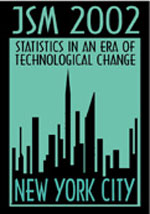|
Activity Number:
|
250
|
|
Type:
|
Contributed
|
|
Date/Time:
|
Tuesday, August 13, 2002 : 2:00 PM to 3:50 PM
|
|
Sponsor:
|
Section on Statistics & the Environment*
|
| Abstract - #301798 |
|
Title:
|
Estimating Percentage Cover via a Multinomial Logit Model
|
|
Author(s):
|
Steven Rein*+ and Michael Curto and Brent Hallock and Craig Stubler
|
|
Affiliation(s):
|
California Polytechnic State University and California Polytechnic State University and California Polytechnic State University and California Polytechnic State University
|
|
Address:
|
, San Luis Obispo, California, 93407,
|
|
Keywords:
|
erosion control
|
|
Abstract:
|
The use of vegetation for erosion control has often coincided with the use of short-term physical methods of erosion control in California. Because native plant species are now preferred to non-natives for erosion control in state funded projects it is important to understand the interrelation between the use of various physical erosion control methods and the establishment of native vegetation. In a $2^2 \times 4$ factorial experiment with 2 replications, we assess the cover in each half of 32 seeded boxes by sampling 10 randomly chosen points along each of 5 randomly chosen transects and determining whether the sampled point is covered by a seeded plant, a plant from the existing seed bank or is uncovered. We propose to estimate the percentage seeded cover and percentage unseeded cover as a function of treatment levels via a multinomial logit model. We will assess both the variance and bias of the multinomial logit and the naïve methods via bootstrapping.
|

